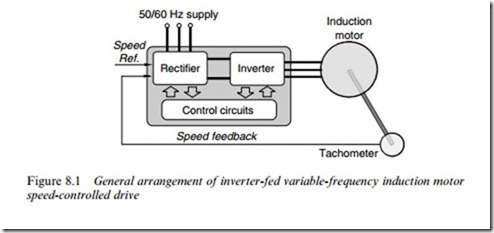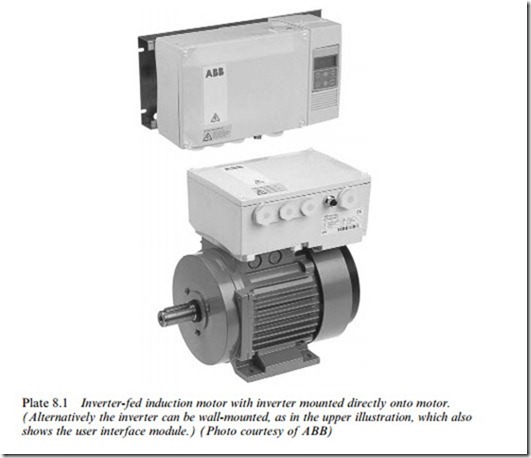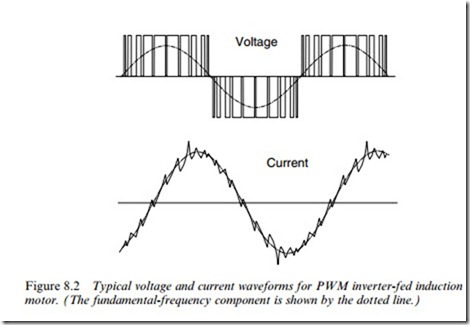INTRODUCTION
We saw in Chapter 6 that the induction motor can only run eYciently at ow slips, i.e. close to the synchronous speed of the rotating Weld. The best method of speed control must therefore provide for continuous smooth variation of the synchronous speed, which in turn calls for variation of the supply frequency. This is achieved using an inverter (as discussed in Chapter 2) to supply the motor. A complete speed control scheme which includes tacho (speed) feedback is shown in block diagram form n Figure 8.1.
We should recall that the function of the converter (i.e. rectiWer and variable-frequency inverter) is to draw power from the Wxed-frequency constant-voltage mains, and convert it to variable frequency, variable voltage for driving the induction motor. Both the rectiWer and the inverter employ switching strategies (see Chapter 2), so the power conversions are accomplished eYciently and the converter can be compact.
Variable frequency inverter-fed induction motor drives are used in ratings up to hundreds of kilowatts. Standard 50 Hz or 60 Hz motors are often used (though as we will see later this limits performance), and the inverter output frequency typically covers the range from around 5–10 Hz up to perhaps 120 Hz. This is suYcient to give at least a 10:1 speed range with a top speed of twice the normal (mains frequency) operating speed. The majority of inverters are 3-phase input and 3-phase output, but single-phase input versions are available up to about 5 kW, and some very small inverters (usually less than 1 kW) are speciWcally intended for use with single-phase motors.
A fundamental aspect of any converter, which is often overlooked, is the instantaneous energy balance. In principle, for any balanced three-phase load, the total load power remains constant from instant to instant, so if it was possible to build an ideal 3-phase input, 3-phase output converter, there would be no need for the converter to include any energy storage elements. In practice, all converters require some energy storage (in capacitors or inductors), but these are relatively small when the input is 3-phase because the energy balance is good. However, as mentioned above, many small and medium power converters are supplied from single-phase mains. In this case, the instantaneous input power is zero at least twice per cycle of the mains (because the voltage and current go through zero every half-cycle). If the motor is 3-phase (and thus draws power at a constant rate), it is obviously necessary to store suYcient energy in the converter to supply the motor during the brief intervals when the load power is greater than the input power. This explains why the most bulky components in many small and medium power inverters are electrolytic capacitors.
The majority of inverters used in motor drives are voltage source inverters (VSI), in which the output voltage to the motor is controlled to suit the operating conditions of the motor. Current source inverters (CSI) are still used, particularly for large applications, but will not be discussed here.
Comparison with d.c. drive
The initial success of the inverter-fed induction motor drive was due to the fact that a standard induction motor was much cheaper than a
Plate 8.1 Inverter-fed induction motor with inverter mounted directly onto motor. (Alternatively the inverter can be wall-mounted, as in the upper illustration, which also shows the user interface module.) (Photo courtesy of ABB)
comparable d.c. motor, and this saving compensated for the relatively high cost of the inverter compared with the thyristor d.c. converter. But whereas a d.c. drive was invariably supplied with a motor provided with laminated Weld poles and through ventilation to allow it to operate continuously at low speeds without overheating, the standard induction motor has no such provision, having been designed primarily for Wxed- frequency full-speed operation. Thus, although the inverter is capable of driving the induction motor with full torque at low speeds, continuous operation is unlikely to be possible because the cooling fan will be ineVective and the motor will overheat.
Now that inverter-fed drives dominate the market, two changes have become evident. Firstly, reputable suppliers now warn of the low-speed limitation of the standard induction motor, and encourage users to opt for a blower-cooled motor if necessary. And secondly, the fact that inverter-fed motors are not required to start direct-on-line at supply frequency means that the design need no longer be a compromise between starting and running performance. Motors can therefore be designed speciWcally for operation from an inverter, and have low- resistance cages giving very high steady-state eYciency and good open- loop speed holding. The majority of drives do still use standard motors, but inverter-speciWc motors with integral blowers are gradually gaining ground.
The steady-state performance of inverter-fed drives is broadly compar- able with that of d.c. drives (except for the limitation highlighted above), with drives of the same rating having similar overall eYciencies and overall torque–speed capabilities. Speed holding is likely to be less good in the induction motor drive, though if tacho feedback is used both systems will be excellent. The induction motor is clearly more robust and better suited to hazardous environments, and can run at higher speeds than the d.c. motor, which is limited by the performance of its commutator.
Some of the early inverters did not employ pulse width modulation (PWM), and produced jerky rotation at low speed. They were also notice- ably more noisy than their d.c. counterparts, but the widespread adoption of PWM has greatly improved these aspects. Most low and medium power inverters use MOSFET or IGBT devices, and may modulate at ultrasonic frequencies, which naturally result in relatively quiet operation.
The Achilles heel of the basic inverter-fed system has been the relatively poor transient performance. For fan and pump applications and high-inertia loads this is not a serious drawback, but where rapid response to changes in speed or load is called for (e.g. in machine tools or rolling mills), the d.c. drive with its fast-acting current-control loop traditionally proved superior. However, it is now possible to achieve equivalent levels of dynamic performance from induction motors, but the complexity of the control naturally reXects in a higher price. Most manufacturers now oVer this so-called ‘vector’ or ‘Weld-oriented’ control (see Section 8.4) as an optional extra for high-performance drives.
Inverter waveforms
When we looked at the converter-fed d.c. motor we saw that the behaviour was governed primarily by the mean d.c. voltage, and that for most purposes we could safely ignore the ripple components. A similar approximation is useful when looking at how the inverter-fed induction motor performs. We make use of the fact that although the actual voltage waveform supplied by the inverter will not be sinusoidal, the motor behaviour depends principally on the fundamental (sinusoidal) component of the applied voltage. This is a somewhat surprising but extremely welcome simpliWcation, because it allows us to make use of our knowledge of how the induction motor behaves with a sinusoidal supply to anticipate how it will behave when fed from an inverter.
In essence, the reason why the harmonic components of the applied voltage are much less signiWcant than the fundamental is that the im- pedance of the motor at the harmonic frequencies is much higher than at the fundamental frequency. This causes the current to be much more sinusoidal than the voltage, as shown in Figure 8.2, and this in turn means that we can expect a sinusoidal travelling Weld to be set up in much the same way as discussed in Chapter 5.
It would be wrong to pretend that the harmonic components have no eVects, of course. They can create unpleasant acoustic noise, and always give rise to additional iron and copper losses. As a result it is common for a standard motor to have to be de-rated (by up to perhaps 5 or 10%) for use on an inverter supply.
As with the d.c. drive the inverter-fed induction motor drive will draw non-sinusoidal currents from the utility supply. If the supply impedance is relatively high signiWcant distortion of the mains voltage waveform is inevitable unless Wlters are Wtted on the a.c. input side, but with normal
industrial supplies there is no problem for small inverters of a few kW rating.
Some inverters now include ‘front-end conditioning’ i.e. an extra high- frequency switching stage and Wlter which ensure that the current drawn from the mains is not only sinusoidal, but also at unity power factor. This feature will become widespread in medium and high power drives to meet the increasingly stringent conditions imposed by the supply authorities.
Steady-state operation – Importance of achieving full flux
Three simple relationships need to be borne in mind to simplify under- standing of how the inverter-fed induction motor behaves. Firstly, we established in Chapter 5 that for a given induction motor, the torque developed depends on the strength of the rotating Xux density wave, and on the slip speed of the rotor, i.e. on the relative velocity of the rotor with respect to the Xux wave. Secondly, the strength or amplitude of the Xux wave depends directly on the supply voltage to the stator windings, and inversely on the supply frequency. And thirdly, the absolute speed of the Xux wave depends directly on the supply frequency.
Recalling that the motor can only operate eYciently when the slip is small, we see that the basic method of speed control rests on the control of the speed of rotation of the Xux wave (i.e. the synchronous speed), by control of the supply frequency. If the motor is a 4-pole one, for example, the synchronous speed will be 1500 rev/min when supplied at 50 Hz, 1200 rev/min at 40 Hz, 750 rev/min at 25 Hz and so on. The no- load speed will therefore be almost exactly proportional to the supply frequency, because the torque at no load is small and the corresponding slip is also very small.
Turning now to what happens on load, we know that when a load is applied the rotor slows down, the slip increases, more current is induced in the rotor, and more torque is produced. When the speed has reduced to the point where the motor torque equals the load torque, the speed becomes steady. We normally want the drop in speed with load to be as small as possible, not only to minimise the drop in speed with load, but also to maximise eYciency: in short, we want to minimise the slip for a given load.
We saw in Chapter 5 that the slip for a given torque depends on the amplitude of the rotating Xux wave: the higher the Xux, the smaller the slip needed for a given torque. It follows that having set the desired speed of rotation of the Xux wave by controlling the output frequency of the inverter we must also ensure that the magnitude of the Xux is adjusted so that it is at its full (rated) value, regardless of the speed of rotation. This is achieved by making the output voltage from the in- verter vary in the appropriate way in relation to the frequency.
We recall that the amplitude of the Xux wave is proportional to the supply voltage and inversely proportional to the frequency, so if we arrange that the voltage supplied by the inverter vary in direct propor- tion to the frequency, the Xux wave will have a constant amplitude. This philosophy is at the heart of most inverter-fed drive systems: there are variations, as we will see, but in the majority of cases the internal control of the inverter will be designed so that the output voltage to frequency ratio (V/f ) is automatically kept constant, at least up to the ‘base’ (50 Hz or 60 Hz) frequency.
Many inverters are designed for direct connection to the mains sup- ply, without a transformer, and as a result the maximum inverter output voltage is limited to a value similar to that of the mains. With a 415 V supply, for example, the maximum inverter output voltage will be per- haps 450 V. Since the inverter will normally be used to supply a standard induction motor designed for say 415 V, 50 Hz operation, it is obvious that when the inverter is set to deliver 50 Hz, the voltage should be 415 V, which is within the inverter’s voltage range. But when the frequency was raised to say 100 Hz, the voltage should – ideally – be increased to 830 V in order to obtain full Xux. The inverter cannot supply voltages above 450 V, and it follows that in this case full Xux can only be maintained up to speeds a little above base speed. (It should be noted that even if the inverter could provide higher voltages, they could not be applied to a standard motor because the winding insulation will have been designed to withstand not more than the rated voltage.) Established practice is for the inverter to be capable of maintaining the V/f ratio constant up to the base speed (50 Hz or 60 Hz), but to accept that at all higher frequencies the voltage will be constant at its maximum value. This means that the Xux is maintained constant at speeds up to base speed, but beyond that the Xux reduces inversely with frequency. Needless to say the performance above base speed is adversely aVected, as we will see.
Users are sometimes alarmed to discover that both voltage and frequency change when a new speed is demanded. Particular concern is expressed when the voltage is seen to reduce when a lower speed is called for. Surely, it is argued, it can’t be right to operate say a 400 V induction motor at anything less than 400 V. The fallacy in this view should now be apparent: the Wgure of 400 V is simply the correct voltage for the motor when run directly from the mains, at say 50 Hz. If this full voltage was applied when the frequency was reduced to say 25 Hz, the implication would be that the Xux would have to rise to twice its rated value.
This would greatly overload the magnetic circuit of the machine, giving rise to excessive saturation of the iron, an enormous magnetising current and wholly unacceptable iron and copper losses. To prevent this from happening, and keep the Xux at its rated value, it is essential to reduce the voltage in proportion to frequency. In the case above, for example, the correct voltage at 25 Hz would be 200 V.


